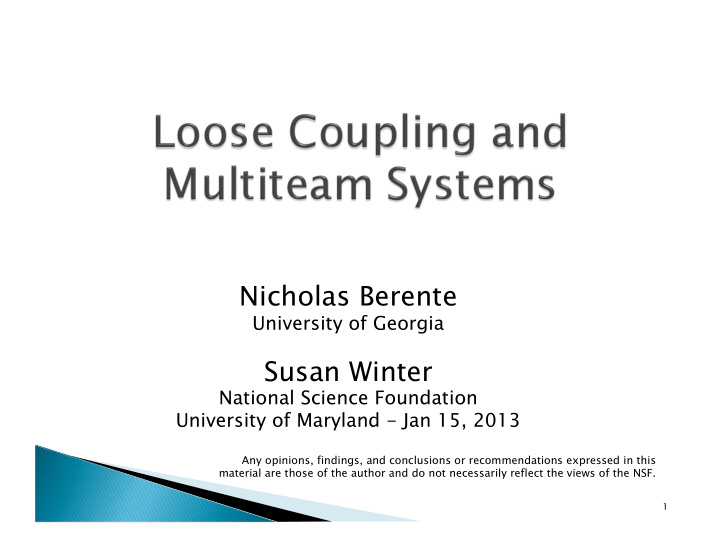



Nicholas Berente University of Georgia Susan Winter National Science Foundation University of Maryland - Jan 15, 2013 Any opinions, findings, and conclusions or recommendations expressed in this material are those of the author and do not necessarily reflect the views of the NSF. 1
Agricultural Revolution ◦ Plow, Land Ownership, Currency ◦ Small Family Farms and Businesses ◦ Independence and Decoupling Components do not communicate, mutually adjust, and act in concert Advantages? Disadvantages?
Industrial Revolution ◦ Steam Engine, Capital, Transportation, Mobile Labor ◦ Central Factory ◦ Tightly Coupled > Fully Integrated Express a high degree of responsiveness among their subsystem components (Orton & Weick 1990) Components communicate, mutually adjust, and act in concert Advantages? Disadvantages?
Digital Revolution/Information Age ◦ Enablers Information and Communication Technologies Globalization of Operations , Shared Resources ( Databases, Equipment/Sensors) (Winter & Taylor 1996; Child & McGrath 2000) ◦ Flexible, Distributed Organizations ◦ Multiteam Systems ◦ Loosely Coupled Components partially responsive to each other Advantages? Disadvantages?
Loose cou Loose couplin pling: Patterns of Action that are Distinct, or Separate, Yet Still Responsive to Each Other (Orton & Weick 1990) Buffering - Environment (Pfeffer & Salancik 1978) - Decisions (March 1978) - Subsystems (Perrow 1984) - Inspection (Meyer & Rowan 1977)
Drivers ◦ Unpredictability ◦ Ambiguity ◦ Novelty ◦ Complexity Distributed Competencies Challenges ◦ Fragmentation ◦ Inefficiency
Solutions ◦ Coordination/Integration Leadership Standardized Processes Information Systems Product Architecture Marks et al. 2005; DeChurch & Marks 2006; Hoegl et al.2004; Argyres 1999; Boland et al. 2007; Baldwin & Clark 2000; Browning 1998; DeChurch & Zaccaro 2010 = Tight Coupling! Why Would You Want Loose Coupling?
Source: Orton & Weick 1990
Source: Berente & Yoo 2012
Lifecycle Stage ◦ Forming ◦ Functioning Degree of Novelty ◦ Novel ◦ Familiar
13
Striking a Balance ◦ Team Independence Flexibility Buffering Innovation ◦ Cross-team Integration Efficiency Data to Test This?
Recommend
More recommend